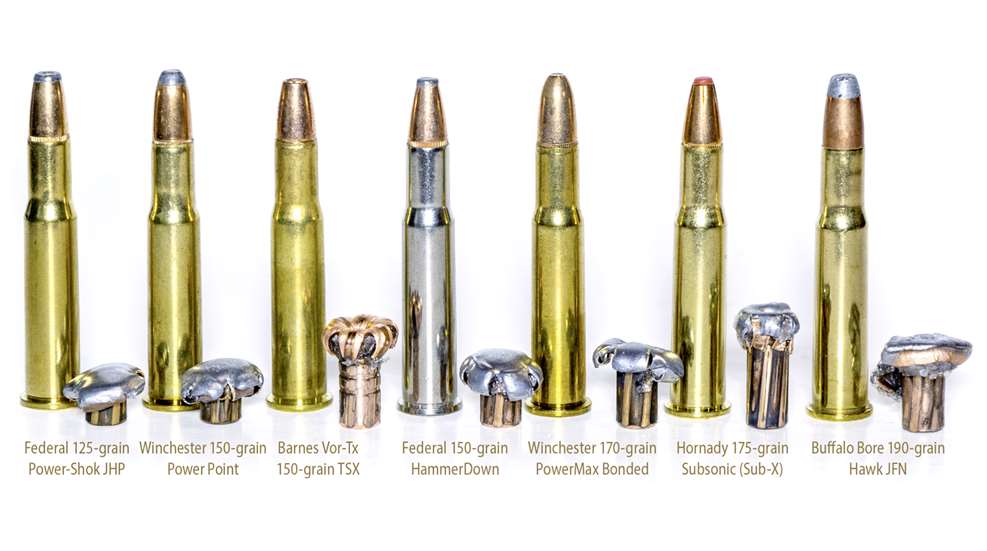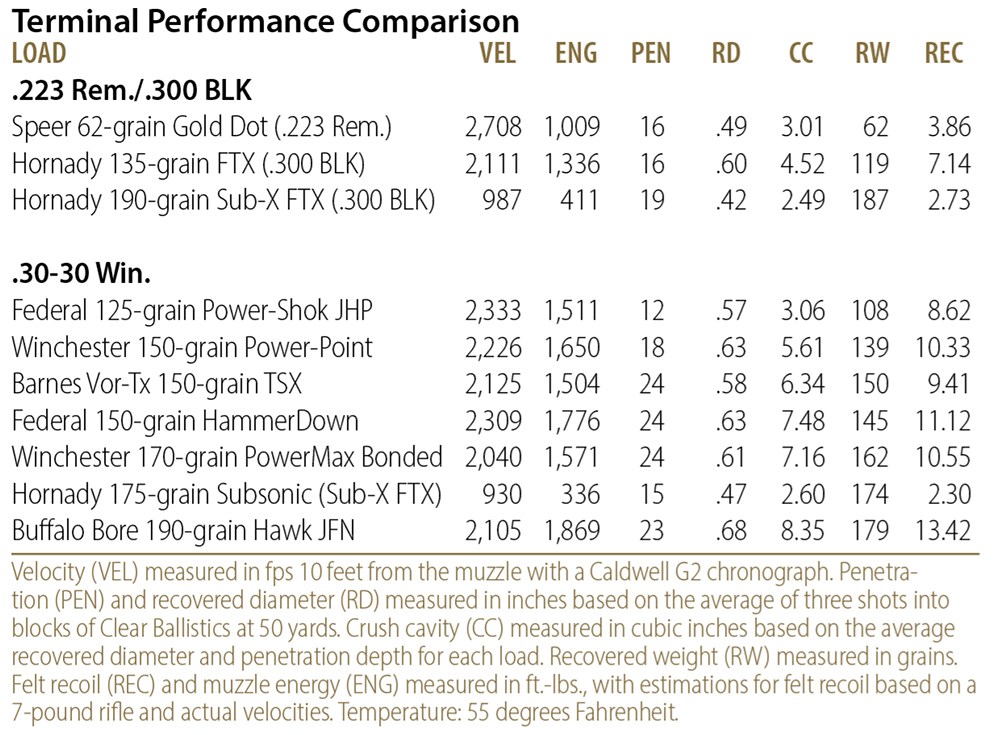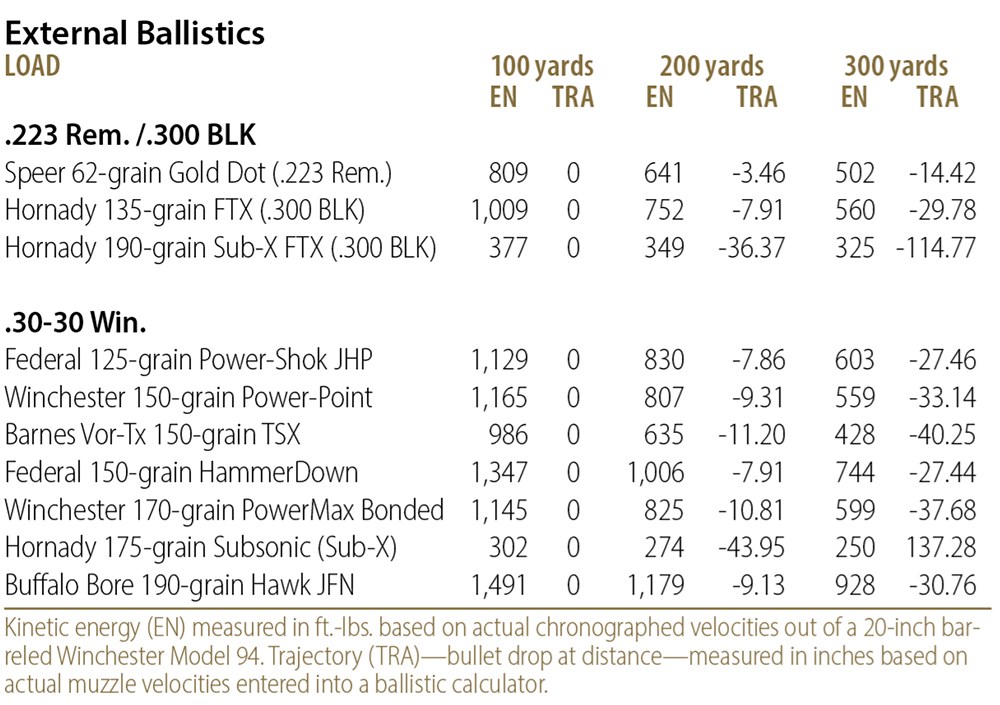
These seven .30-30 Win. loads represent a good sampling of available options for the venerable cartridge.
The modern carbine cartridge—the .223 Rem.—has been with us since the early 1960s. Since then, we’ve seen its case altered to make other cartridges, and we’ve also seen new carbine-compatible introductions based on other cartridge cases. The purpose of all these cartridges was to provide either more reach, a harder punch or improved subsonic performance out of the AR-15 platform for recreation, competition, tactical and hunting applications. Ironically, during this whirlwind of cartridge development, many forgot one of the greatest carbine cartridges: .30-30 Win.
The .30-30 Win. was America’s first sporting cartridge to use smokeless powder. It was originally known as the .30 Win. Smokeless or .30 Win. Centerfire (.30 WCF) and fired a 160-grain bullet at 1,970 fps. Those ballistics—and the name—have since been enhanced. Because Marlin did not want “Winchester” stamped on its rifle’s barrels, the company called it the .30-30 Smokeless, which stood for a .30-caliber bullet and 30 grains of smokeless powder. Soon, the cartridge became known simply as the .30-30, or more culturally as the “thutty-thutty.” SAAMI (Sporting Arms and Ammunition Manufacturer’s Institute) sets the standards for all American made firearms and ammunition and SAAMI lists the correct name for the cartridge as: 30-30 Winchester, abbreviated as .30-30 Win.
I know, you’re probably thinking the Shooting Illustrated ammo editor you’ve trusted for more than a decade has finally Fudded-out by hawking a cartridge that’s more than 100 years old. Of course, no one seems to complain when I praise the 9 mm or the .45 ACP, both of which are also more than a century old. No, the .30-30 Win. will not work in a modern semi-automatic carbine based on the AR-15 platform, but cartridge designers have tried to duplicate .30-30 performance in the AR-15 for about half as long as the .30-30 has been around. Surely, you’ve not forgotten the .300 BLK is often heralded as the equal of the .30-30 Win.
The .30-30 Win. lives in another carbine—the lever-action carbine. With a 20-inch barrel, it’s about the same length as the more modern AR-15 and weighs about the same, too. Gunsite Academy founder and gunwriter Col. Jeff Cooper was a believer in the lever action, specifically the Winchester Model 1894. He considered it an ideal backup long gun for police, felt it superior to the AK-47 and wrote, “The little ‘94 Winchester in .30-30 continues to delight us. It is no 400-meter weapon, but 400 meters is a fanciful range for any but certain specialties. Out to 200 meters it does just fine ... .”
But, this column is not about rifles, it’s about ammunition, and to appreciate what the .30-30 Win. cartridge can offer, you need to understand the ammunition available for it. A major online retailer—MidwayUSA—lists 35 different factory loads for the .30-30, with bullets ranging from 125 to 190 grains. These loads include full-power, reduced-recoil and even subsonic options, with prices from about $1.25 to $5.20 per round. To give you an idea of the terminal performance this cartridge can deliver, I tested six of those 35 loads by shooting them into blocks of Clear Ballistics at 50 yards.
Admittedly, the .30-30 Win. is most often used as a cartridge for hunting game, and the most common load for it is a 150-grain bullet. Three of the loads tested utilize a 150-grain bullet and their penetration ranged from 18 to 24 inches, with resulting crush cavities measuring from 5.61 to 7.48 cubic inches. For most self/home-defense applications, this much penetration is excessive. Two other .30-30 Win. loads offer terminal performance much more suitable for that purpose.
The Federal 125-grain Power-Shok JHP load only penetrates to about a foot and with the frontal diameter of the bullet opening to a bit more than a half-inch, you get 9 mm-like crush cavities, but with substantially more energy. In fact, this load will deliver 50-percent more energy than you might see with the best .223 Rem./5.56 NATO loads. The 175-grain Hornady Subsonic .30-30 Win. load delivers energy on target that’s comparable to the 9 mm, with penetration to about 15 inches, and it recoils about half as much as the
.223 Rem./5.56 NATO does out of an AR-15.
If defeating intermediate barriers is a major concern, all the .30-30 loads perform reasonably well, with the mono-metal and bonded bullets performing the best. This is partly because mono-metal and bonded bullets work well against tough barriers, but also because the velocity of the .30-30 Win. does not over-stress conventional bullets. If knocking the snot out of something is your primary concern, look at the 190-grain Hawk bullet load from Buffalo Bore. It generates nearly 2,000 ft.-lbs. of energy at the muzzle and at 300 yards still has almost 1,000 ft.-lbs. According to Tim Sundles at Buffalo Bore, “The .30-30 can now be carried as a defensive tool in grizzly country and will be much more effective in stopping a grizzly attack than any other .30-30 ammunition in the world.”
I’m not sharing all this praise and information on the .30-30 Win. to convince you to trade in your AR-15. I believe the AR-15 is the best home-defense carbine available. I offer
it for two reasons. First, to show you that we’ve had a practical home-defense cartridge/carbine available to us for more than 100 years. And secondly, to let you know that if you do have one, you don’t need to feel under-gunned. This is especially true if you might be more worried about a bear instead of a bad guy invading your home. In fact, given the popularity of the .30-30—you can find ammo from coast to coast, in mom-and-pop gas stations, under truck seats and in old barns—it’s an excellent choice for a long-term survival cartridge.
The .30-30 Win. has served admirably as America’s behind-the-kitchen-door gun for more than a century, and in some homes it still fills that role. It will handle bad guys, bad bears, wookalars and werewolves. If you’re in fear of the latter, try Winchester’s Ballistic Silvertip load. No, it’s not a real silver bullet, but werewolves aren’t real, either. If they were, I’m sure we’d have a .30-30 Win. load designed just for them.







































